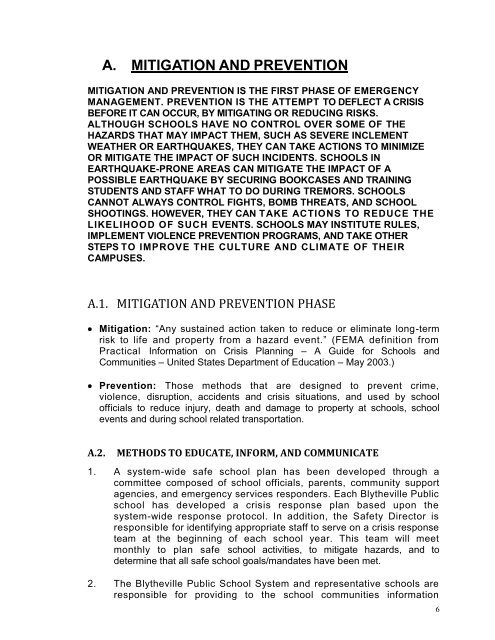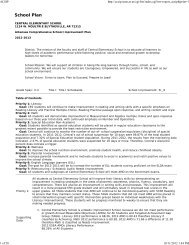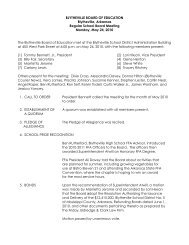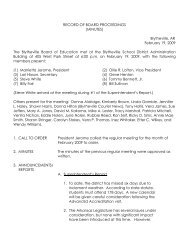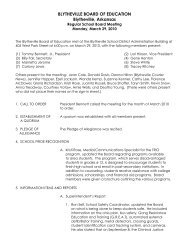District-Wide Safe Schools and Crisis Plan - Blytheville Public Schools
District-Wide Safe Schools and Crisis Plan - Blytheville Public Schools
District-Wide Safe Schools and Crisis Plan - Blytheville Public Schools
Create successful ePaper yourself
Turn your PDF publications into a flip-book with our unique Google optimized e-Paper software.
A. MITIGATION AND PREVENTION<br />
MITIGATION AND PREVENTION IS THE FIRST PHASE OF EMERGENCY<br />
MANAGEMENT. PREVENTION IS THE ATTEMPT TO DEFLECT A CRISIS<br />
BEFORE IT CAN OCCUR, BY MITIGATING OR REDUCING RISKS.<br />
ALTHOUGH SCHOOLS HAVE NO CONTROL OVER SOME OF THE<br />
HAZARDS THAT MAY IMPACT THEM, SUCH AS SEVERE INCLEMENT<br />
WEATHER OR EARTHQUAKES, THEY CAN TAKE ACTIONS TO MINIMIZE<br />
OR MITIGATE THE IMPACT OF SUCH INCIDENTS. SCHOOLS IN<br />
EARTHQUAKE-PRONE AREAS CAN MITIGATE THE IMPACT OF A<br />
POSSIBLE EARTHQUAKE BY SECURING BOOKCASES AND TRAINING<br />
STUDENTS AND STAFF WHAT TO DO DURING TREMORS. SCHOOLS<br />
CANNOT ALWAYS CONTROL FIGHTS, BOMB THREATS, AND SCHOOL<br />
SHOOTINGS. HOWEVER, THEY CAN TAKE ACTIONS TO REDUCE THE<br />
LIKELIHOOD OF SUCH EVENTS. SCHOOLS MAY INSTITUTE RULES,<br />
IMPLEMENT VIOLENCE PREVENTION PROGRAMS, AND TAKE OTHER<br />
STEPS TO IMPROVE THE CULTURE AND CLIMATE OF THEIR<br />
CAMPUSES.<br />
A.1. MITIGATION AND PREVENTION PHASE<br />
Mitigation: “Any sustained action taken to reduce or eliminate long-term<br />
risk to life <strong>and</strong> property from a hazard event.” (FEMA definition from<br />
Practical Information on <strong>Crisis</strong> <strong>Plan</strong>ning – A Guide for <strong>Schools</strong> <strong>and</strong><br />
Communities – United States Department of Education – May 2003.)<br />
Prevention: Those methods that are designed to prevent crime,<br />
violence, disruption, accidents <strong>and</strong> crisis situations, <strong>and</strong> used by school<br />
officials to reduce injury, death <strong>and</strong> damage to property at schools, school<br />
events <strong>and</strong> during school related transportation.<br />
A.2. METHODS TO EDUCATE, INFORM, AND COMMUNICATE<br />
1. A system-wide safe school plan has been developed through a<br />
committee composed of school officials, parents, community support<br />
agencies, <strong>and</strong> emergency services responders. Each <strong>Blytheville</strong> <strong>Public</strong><br />
school has developed a crisis response plan based upon the<br />
system-wide response protocol. In addition, the <strong>Safe</strong>ty Director is<br />
responsible for identifying appropriate staff to serve on a crisis response<br />
team at the beginning of each school year. This team will meet<br />
monthly to plan safe school activities, to mitigate hazards, <strong>and</strong> to<br />
determine that all safe school goals/m<strong>and</strong>ates have been met.<br />
2. The <strong>Blytheville</strong> <strong>Public</strong> School System <strong>and</strong> representative schools are<br />
responsible for providing to the school communities information<br />
6


